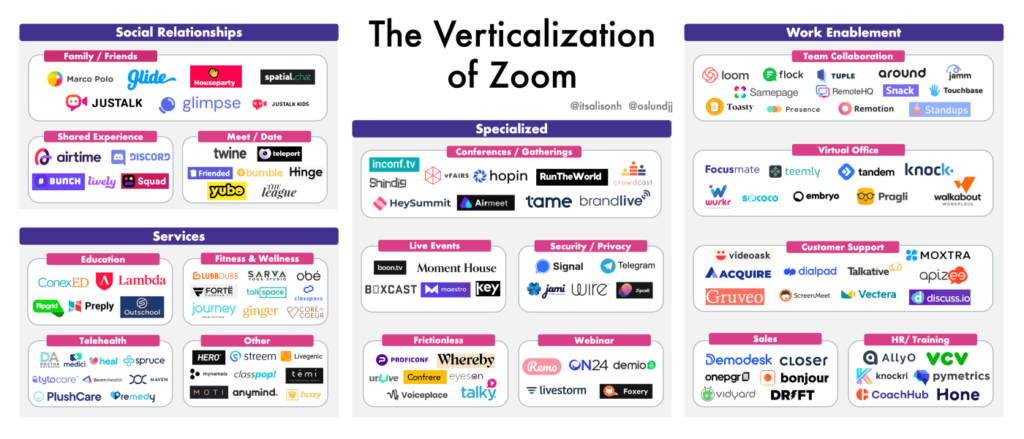
SUMMARY
Savvy founders know that finding the right market at the right time can be like a cheat code for startup success
Video is the best solution for jobs that require establishing a closer human connection
Vertically-focused startups design products to better meet the needs of particular user segments
How startups are building the future of video conferencing by carving out their own verticals?

At first glance, the video conferencing market looks oversaturated and impenetrable for newcos. While many VCs had this same sentiment in Zoom’s early days, the environment only looks more daunting as tech giants like Zoom, Microsoft, Google, Cisco, and even Verizon take part in the land grab.
While history does tend to repeat itself, we’ve been observing two growing trends that may pose even larger threats to Zoom than any of its direct competitors:
- Verticalization: building vertically-focused applications tailored to particular use cases
- Unbundling: the productization of underlying technology and features that make it easier to build custom solutions
Just as natural forces reshape landscapes over time, verticalization and unbundling are natural processes that have been observed whenever any business dominates a horizontal market — such as Craigslist, Linkedin, or G Suite. Profitable markets attract startups and adjacent competitors that carve out verticals or products that they can better serve. Jeff Jordan and D’Arcy Coolican explore this phenomenon as it relates to platforms:
Savvy founders know that finding the right market at the right time can be like a cheat code for startup success. Looking at verticals within the broad horizontal platforms that are near their breaking point is like a cheat code for a cheat code: if you’re paying attention, it will point you to the next great unbundling and where the next wave of opportunity and innovation will come from.
In this first post, we will look at how the verticalization of video conferencing is unfolding today and what the long term impact will be for general-purpose tools like Zoom.
Why Verticalization is Necessary
Companies like Zoom that achieve massive growth and ubiquity lose one important competitive advantage: the ability to focus on a particular user. Recent events have forced the adoption of Zoom for use cases that it was not originally designed for. Teachers struggle to manage a classroom. Game nights with friends feel overly rigid. Working on a project with coworkers becomes inefficient. Zoom has become the lowest common denominator that works for everyone, yet it is not perfectly suited for anyone.

Vertically-focused startups design products to better meet the needs of particular user segments. This allows them to create and capture more value than a horizontal product like Zoom is able to. While Zoom can be used to facilitate a small event, startups like Hopin offer features like 1:1 networking, virtual booths, and integrated registration in order to reduce the complexity for organizers. The additional value that Hopin provides allows it to better monetize events, which is why it is possible to build large businesses within these narrower verticals.
A Job for Video Conferencing
Before we list out every possible “Zoom for X” that startups could build, we need to first understand the Job to Be Done that video solves. While video is certainly not the best solution for all types of communication, it is the closest substitute for that we have for in-person interactions today.
Humans communicate through words, voice intonation, facial expressions, and body language. Video provides this higher fidelity communication and reduces ambiguity that often occurs over audio and text. Still, video has its shortcomings. As Steve Blank points outs, video cannot replace a hug or handshake, more subtle non-verbal cues, and the shared experience of occupying the same spatial context.
Therefore, video is the best solution for jobs that require establishing a closer human connection — whether that means building trust, negotiating a deal, or forming a friendship. Vertical applications are best able to facilitate this human connection in the context of a particular job at hand. Below, we’ll walk through the four categories of vertical solutions that are emerging today:

1) Social Connections
Before Zoom infiltrated our wider social spheres, general-purpose apps like Facetime were used to connect family and friends. Quarantines have helped normalized video chats and have onboarded many of the remaining “late majority” adopters. Social acceptance and improved digital experiences will usher a new wave of growth in friendly hangouts (House Party), shared screens (Squad), asynchronous catchups (Marco Polo), or finding love (Bumble).
2) Service offerings
Video communication gives service providers and creators greater flexibility to work remotely and scale their business — both of which are accelerating the passion economy. Remote education tools help online tutors (Preply) and teachers (Outschool) reach students. Others allow fitness trainers (Class Pass), real estate agents (CloudPano), chefs (ClassPop), and retail workers (Hero) to continue engaging clients. The social normalization of video communication will also continue to accelerate the acceptance of remote patient care for mental health (Talkspace), physical wellbeing (Medici), and pet care (Fuzzy Pet Health).
3) Work Communication
As teams become increasingly distributed, video communication is important for both internal alignment and external business development. Purpose-built communication tools help enable more effective team stand-ups (Standups), ongoing team communication (Tandem), working sessions (Remote HQ), and spontaneous watercooler chats (Snack). Others are enabling sales calls (Demodesk), asynchronous communication (Loom), workplace training (Hone), and less-distracting communication (Focusmate).
4) Specialized Solutions
Video tools are also designed around the structural needs of a given use case. Some promise more secure, decentralized, and private video chats (as Telegram announced recently). On the opposite spectrum, other applications try removing as much friction as much as possible (Whereby). Startups are also improving webinars (Livestorm), performances (Moment House), and interactive events (Hopin) to make group video communication more engaging and intimate.
The Meta-Layer
Even as verticalized applications grow, Zoom and its general-purpose competitors will continue evolving as horizontal “meta-layers” for communication. Kevin Kwok explores a similar concept for how collaboration within workflow applications (like Figma) are reducing the need for meta-layer applications like Slack:
More and more apps in all categories understand that collaboration should and must be built in as a first party if they want to best serve their customers. Notion, Airtable, etc all understand this. The feedback loops of collaboration get so short that they become part of the productivity loop.
In the same way that in-app collaboration improves productivity, in-app video communication improves human connection. These tailored applications can reduce the “Zoom fatigue” that results from cookie-cutter user experiences that are not optimized for the task at hand. There will always be edge-cases for meta-layer tools like Zoom, but newcos that provide this more natural, contextual human connection will also be able to capture the value around that interaction.
Zoom won with a superior product, but the mass adoption, changing consumer behaviors, and reduced friction to build video tools will continue to usher in a wave of vertically-focused companies that enable remote human connection for every use case. Stay tuned for Part 2 — “The Unbundling of Zoom” where we look at the companies creating the foundations for vertical applications and users to build their own custom video communication stack.
[The article first appeared on Medium and has been reposted with permission.]


























